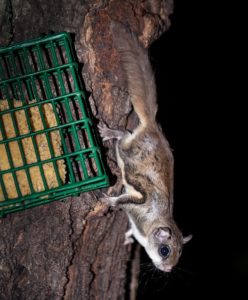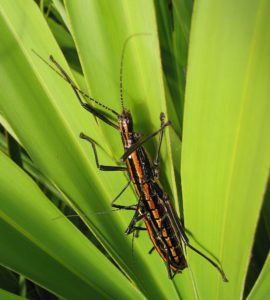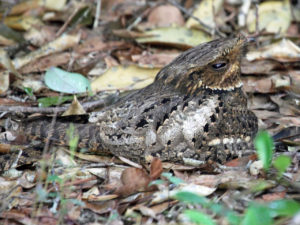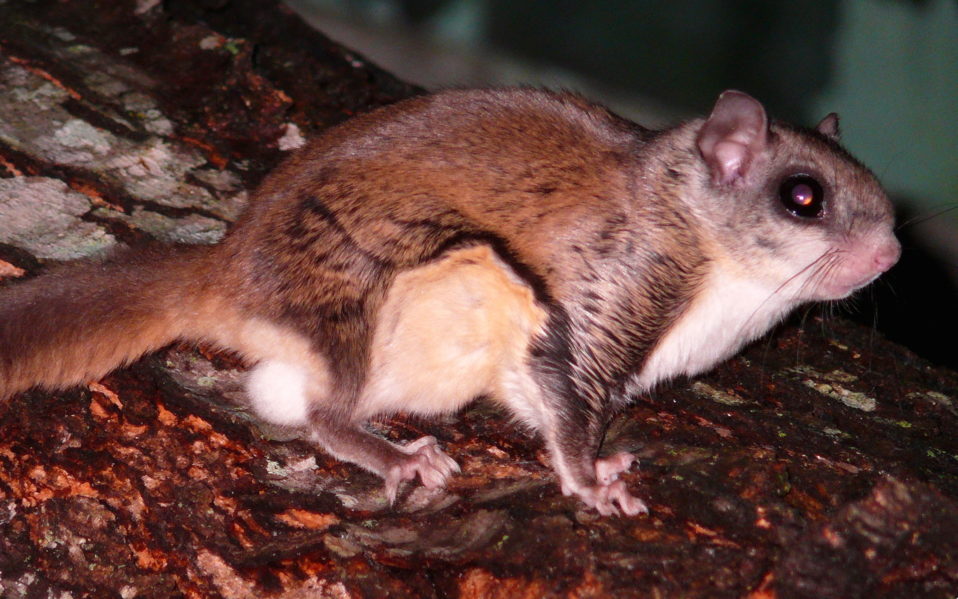Wildlife Wednesday: Nocturnal Creatures of the NDC
Most of us hike and amble around the Nature Discovery Center during the day, but there is plenty of life afoot and active at night. On some of our night hikes, with flashlights in hand, we’re able to find some of these nocturnal animals. This week, we’ll take a look at a few species that we find in the park at night, and you may be able to find around your home, as well.
 Southern Flying Squirrels (Glaucomys volans) usually pass underneath our radar, as the only nocturnal tree squirrel in our area. That’s right, a nocturnal squirrel! Flying squirrels don’t actually fly, the way that bats, birds, and insects can, but rather they glide using skin flaps between the front and back legs. They are incredibly adept at controlling the direction of their glide by adjusting these flaps. Each flap is called a patagium. Like other tree squirrels, flying squirrels eat mainly seeds and nuts, and supplement their diet with insects and small vertebrates occasionally. they nest or shelter in tree holes, like old woodpecker nests and natural hollows formed from the scars of fallen branches. They’re our smallest squirrels, with a body length of only about 5 inches.
Southern Flying Squirrels (Glaucomys volans) usually pass underneath our radar, as the only nocturnal tree squirrel in our area. That’s right, a nocturnal squirrel! Flying squirrels don’t actually fly, the way that bats, birds, and insects can, but rather they glide using skin flaps between the front and back legs. They are incredibly adept at controlling the direction of their glide by adjusting these flaps. Each flap is called a patagium. Like other tree squirrels, flying squirrels eat mainly seeds and nuts, and supplement their diet with insects and small vertebrates occasionally. they nest or shelter in tree holes, like old woodpecker nests and natural hollows formed from the scars of fallen branches. They’re our smallest squirrels, with a body length of only about 5 inches.
Two-striped Stick Insects (Anisomorpha bupestroides) leave marks on the Buttonbush leaves and other plants they eat from, all over the park. However, unless you uncover them under a rock or a log, you won’t see them during the daytime. If you find them, climbing through the bushes at night, you’re likely to notice that a smaller one appears to be riding a larger one. The males will actually attach themselves to the females while mating, for up to 2 weeks, to ensure that no other males mate with the female. This practice gives rise to the colloquial name in the South of “Devil Riders”. You should be careful when approaching these insects, as they are capable of releasing a caustic and toxic liquid from their back ends that may burn the skin and severely irritate the eyes. It’s best to admire them from a bit of a distance.
 Mediterranean Geckos (Hemidactylus turcicus), as the name would suggest, are not from around here, but rather are originally from the Mediterranean coastal region of North Africa. Through shipping and international trade, they have been spread from there to coastal areas around the world. They have an especially vibrant population in the Houston-Galveston area of Texas, but can be found in larger cities around the state, like San Antonio, Austin, and Dallas, as well. They are our only nocturnal lizard. As with most geckos, they climb exceptionally well, and feed on insects and other invertebrates.
Mediterranean Geckos (Hemidactylus turcicus), as the name would suggest, are not from around here, but rather are originally from the Mediterranean coastal region of North Africa. Through shipping and international trade, they have been spread from there to coastal areas around the world. They have an especially vibrant population in the Houston-Galveston area of Texas, but can be found in larger cities around the state, like San Antonio, Austin, and Dallas, as well. They are our only nocturnal lizard. As with most geckos, they climb exceptionally well, and feed on insects and other invertebrates.

Chuck-Will’s-Widow (Antrostomus carolinensis) isn’t always found in the par all year round, but often stop over in the park during Spring and Fall Migration. These very well camouflaged birds, in the nightjar family, are heard more than seen. They are of course known for their loud CHUCK WILLS WIDOW call (listen here). These enigmatic birds fly through the night, feeding on flying insects by scooping them up in their huge mouths. They usually appear on the Western fence line of the park.
Thanks for joining us for another Wildlife Wednesday. Keeping in mind, that the park closes to the public at 9 PM, feel free to come out after dark sometime, with a flashlight, to check out our nocturnal wildlife for yourself. Also, you could join us for a group night hike, or with a group of 5 or more, schedule one with a staff naturalist for yourself.
Cheers, and see you soon!
Eric Duran
Staff Naturalist
photographs: Top Flying Squirrel by Ken Thomas | Wiki; Flying Squirrel by Judy Frederick | Flickr; Stick Insects by Bugenstien | Wiki; Gecko by Zoofari | Wiki; Chuck-will’s-widow by Dick Daniels | Wiki



